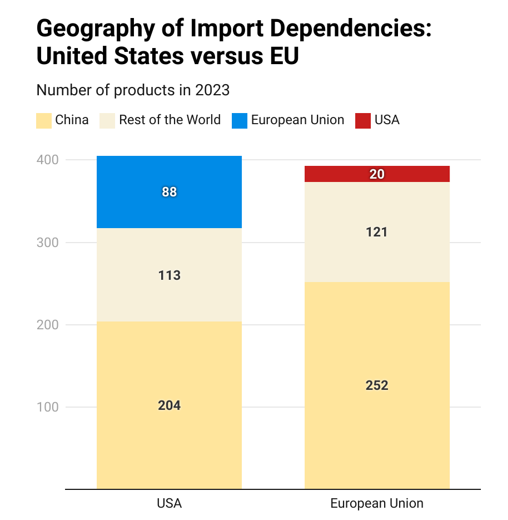
Bilateral Vulnerability to Imports Is Higher in the United States than in Europe
The tariff strategy implemented since Donald Trump's inauguration has drawn attention to the extent of the U.S. economy's dependence on imports. The European Union (EU) ranks second among the suppliers on which the United States relies the most.
By Kevin Lefebvre, Pauline Wibaux
The number of imported products for which the United States and the EU each have a single main supplier is similar: 405 for the U.S. and 393 for the EU in 2023. China is the leading source, exporting more than half of these products to both economies. Within the transatlantic partnership, the United States is more dependent on imports from the European Union than the EU is on its American partner: one-fifth of the U.S.'s dependent products (88 in total) are mainly supplied by the EU, while only 5% of the EU’s dependencies (20 products) primarily come from the United States.
U.S. dependencies on the EU are concentrated in chemicals and pharmaceuticals (25 products), machinery and equipment (18), as well as food products (9) and textiles (8). European dependencies on the United States mainly concern chemical and pharmaceutical products (9 items).
For further information, see the CEPII’s EU–US Trade Dashboard, and read Import Dependencies: Where Does the EU Stand? and Dépendances commerciales : si la Chine est en position dominante, l’Union européenne n’est pas dépourvue d’atouts.
U.S. dependencies on the EU are concentrated in chemicals and pharmaceuticals (25 products), machinery and equipment (18), as well as food products (9) and textiles (8). European dependencies on the United States mainly concern chemical and pharmaceutical products (9 items).
For further information, see the CEPII’s EU–US Trade Dashboard, and read Import Dependencies: Where Does the EU Stand? and Dépendances commerciales : si la Chine est en position dominante, l’Union européenne n’est pas dépourvue d’atouts.

An economy's dependence on imports of a given product (at the 6-digit level of the Harmonized System nomenclature) is measured here according to four criteria: the geographical concentration of that economy's imports; the geographical concentration of global exports; the substitutability of imports by exports; and the duration of the dependence.
Source: CEPII, EU–US Trade Dashboard.
Source: CEPII, EU–US Trade Dashboard.
< Back

